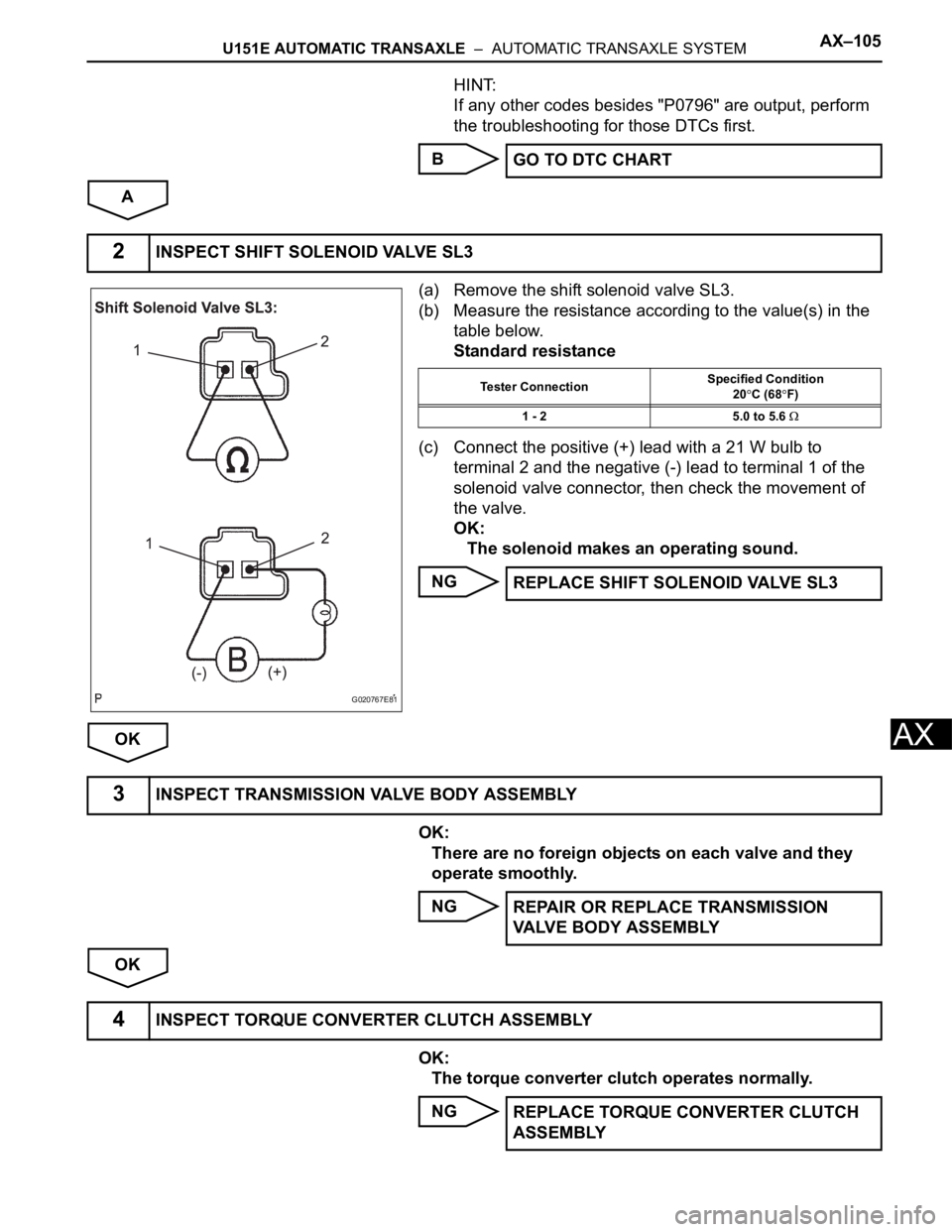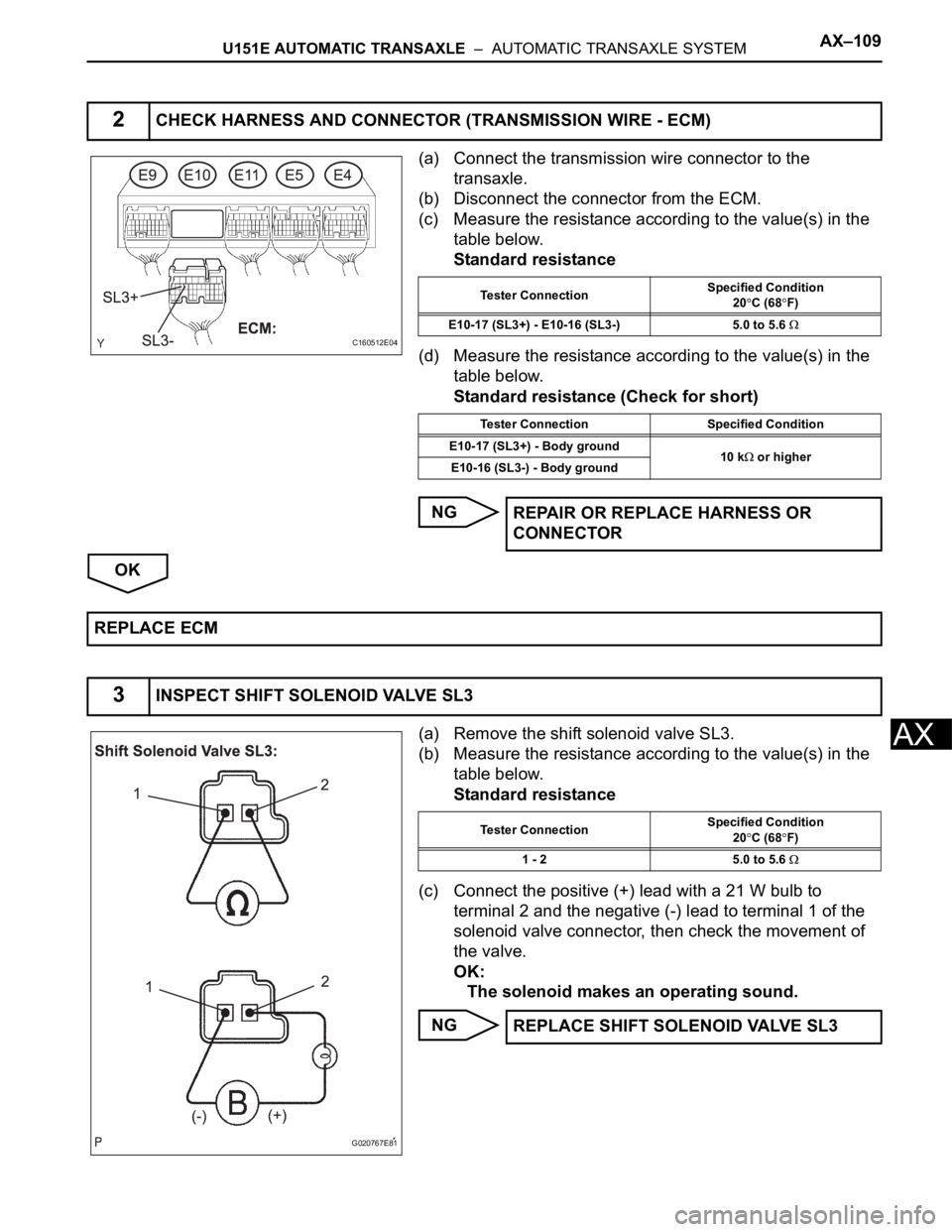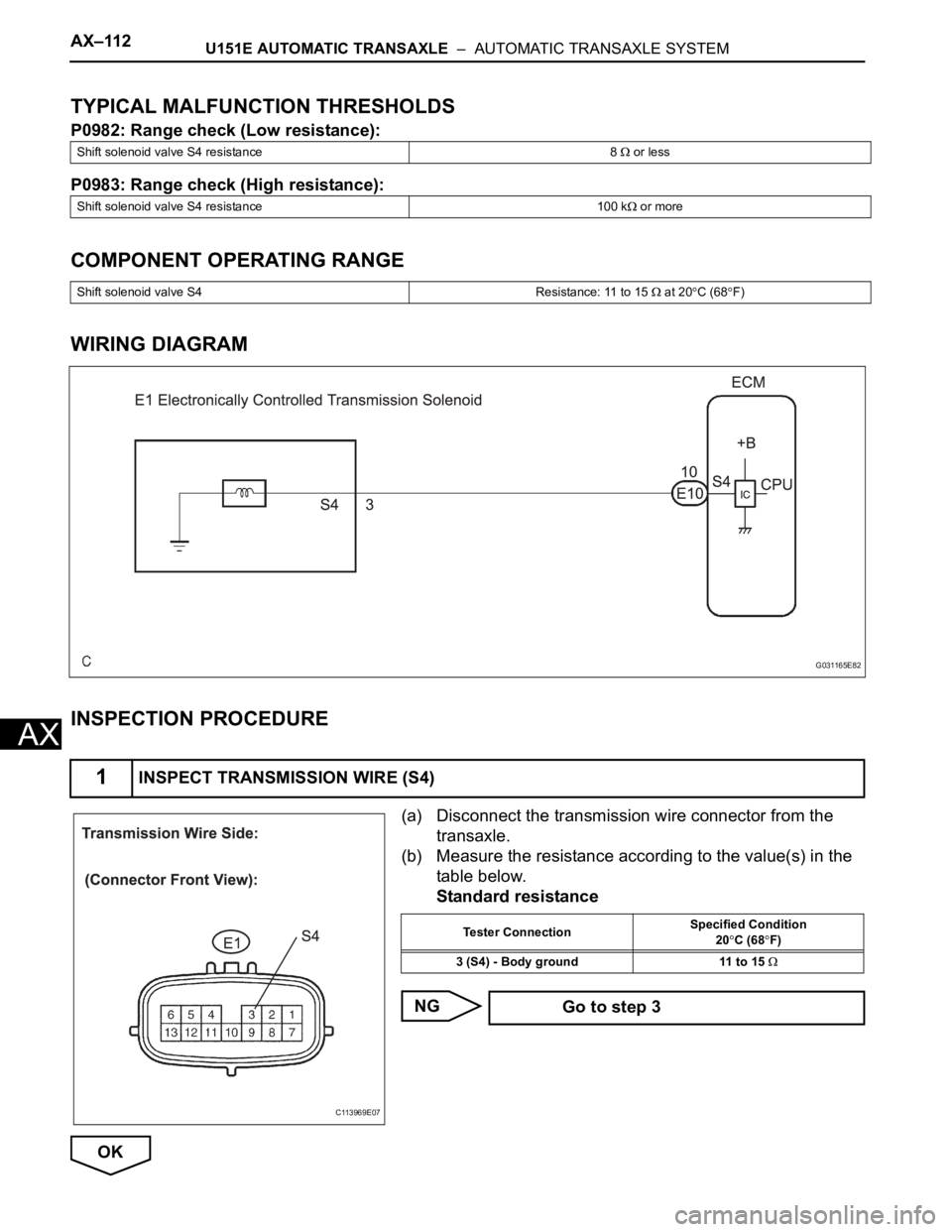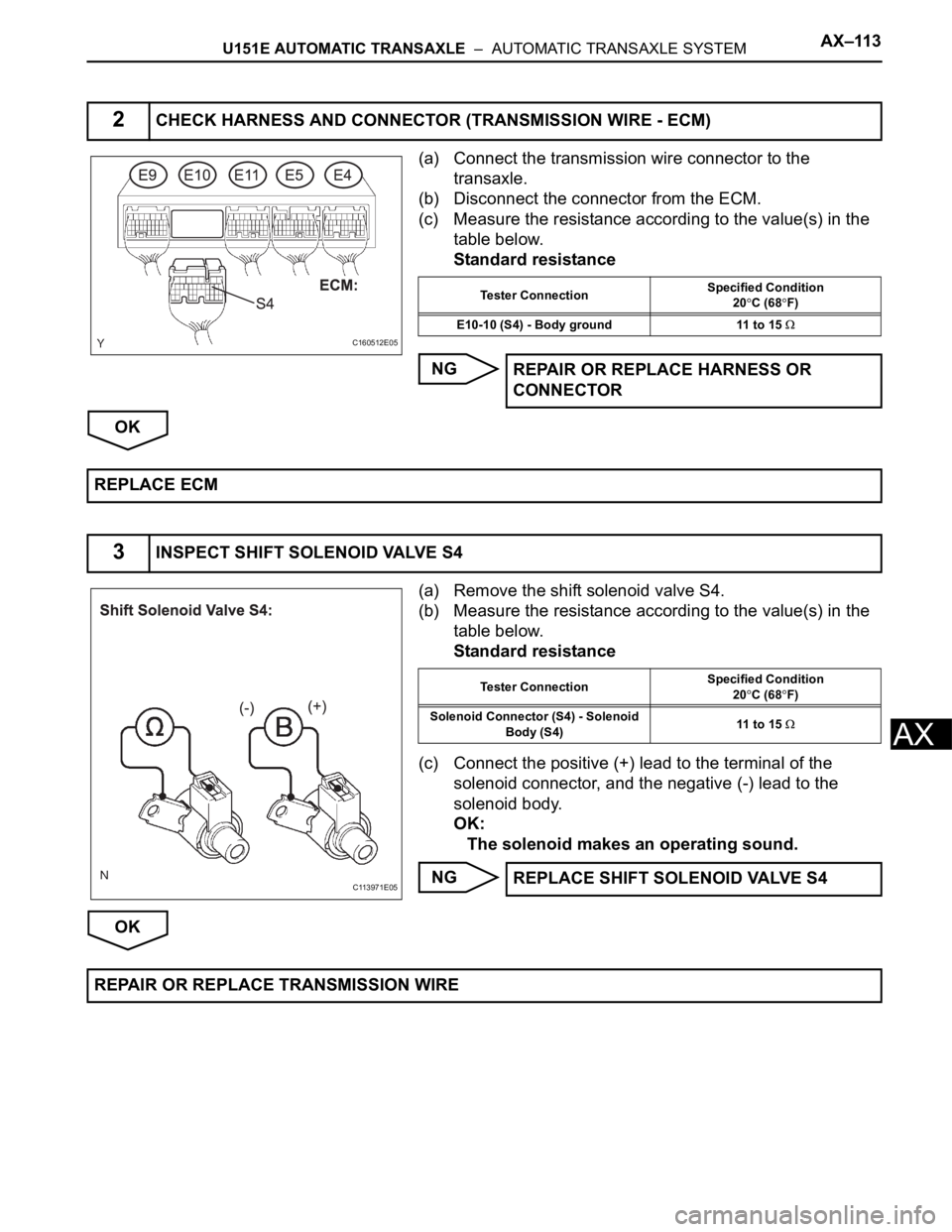2007 TOYOTA SIENNA shift solenoid
[x] Cancel search: shift solenoidPage 1470 of 3000

AX–104U151E AUTOMATIC TRANSAXLE – AUTOMATIC TRANSAXLE SYSTEM
AX
INSPECTION PROCEDURE
HINT:
Using the intelligent tester to perform ACTIVE TEST allows relays, VSVs, actuators and other items to be
operated without removing any parts. This non-intrusive functional inspection can be very useful because
intermittent operation may be discovered before parts or wiring is disturbed. Performing ACTIVE TEST
early in troubleshooting is one way to save diagnostic time. DATA LIST information can be displayed while
performing ACTIVE TEST.
1. PERFORM ACTIVE TEST
(a) Warm up the engine.
(b) Turn the ignition switch off.
(c) Connect the intelligent tester together with the CAN VIM (controller area network vehicle
interface module) to the DLC3.
(d) Turn the ignition switch to the ON position.
(e) Turn on the tester.
(f) Select the item "DIAGNOSIS / ENHANCED OBD II / ACTIVE TEST / SHIFT".
(g) According to the display on the tester, perform the "ACTIVE TEST".
HINT:
While driving, the shift position can be forcibly changed with the intelligent tester.
Comparing the shift position commanded by the ACTIVE TEST with the actual shift position enables you
to confirm the problem (See page AX-30).
HINT:
• This test can be conducted when the vehicle speed is 50 km/h (31 mph) or less.
• The shift position commanded by the ECM is shown in the DATA LIST/SHIFT display on the intelligent
tester.
(a) Connect the intelligent tester together with the CAN VIM
(controller area network vehicle interface module) to the
DLC3.
(b) Turn the ignition switch to the ON position and turn the
OBD II scan tool or the intelligent tester main switch ON.
(c) When you use intelligent tester:
Select the item "DIAGNOSIS / ENHANCED OBD II /
DTC INFO / CURRENT CODES".
(d) Read the DTCs using the OBD II scan tool or the
intelligent tester.
Result
Tester Display Test Part Control Range Diagnostic Note
SHIFT[Test Details]
Operate the shift solenoid valve and set the each
shift position by yourself.
[Vehicle Condition]
• IDL: ON
• Less than 50 km/h (31 mph)
[Others]
•Press "
" button: Shift up
•Press "" button: Shift down1st/2nd/3rd/4th/5thPossible to check the
operation of the shift
solenoid valves.
1CHECK OTHER DTCS OUTPUT (IN ADDITION TO DTC P0796)
Result Proceed to
P0796 A
P0796 and other DTCs B
Page 1471 of 3000

U151E AUTOMATIC TRANSAXLE – AUTOMATIC TRANSAXLE SYSTEMAX–105
AX
HINT:
If any other codes besides "P0796" are output, perform
the troubleshooting for those DTCs first.
B
A
(a) Remove the shift solenoid valve SL3.
(b) Measure the resistance according to the value(s) in the
table below.
Standard resistance
(c) Connect the positive (+) lead with a 21 W bulb to
terminal 2 and the negative (-) lead to terminal 1 of the
solenoid valve connector, then check the movement of
the valve.
OK:
The solenoid makes an operating sound.
NG
OK
OK:
There are no foreign objects on each valve and they
operate smoothly.
NG
OK
OK:
The torque converter clutch operates normally.
NGGO TO DTC CHART
2INSPECT SHIFT SOLENOID VALVE SL3
G020767E81
Tester ConnectionSpecified Condition
20C (68F)
1 - 2 5.0 to 5.6
REPLACE SHIFT SOLENOID VALVE SL3
3INSPECT TRANSMISSION VALVE BODY ASSEMBLY
REPAIR OR REPLACE TRANSMISSION
VALVE BODY ASSEMBLY
4INSPECT TORQUE CONVERTER CLUTCH ASSEMBLY
REPLACE TORQUE CONVERTER CLUTCH
ASSEMBLY
Page 1473 of 3000

U151E AUTOMATIC TRANSAXLE – AUTOMATIC TRANSAXLE SYSTEMAX–107
AX
DESCRIPTION
Shifting from 1st to 5th is performed in combination with "ON" and "OFF" operation of the shift solenoid
valves SL1, SL2, SL3, S4 and SR which are controlled by the ECM. If an open or short circuit occurs in
either of the shift solenoid valves, the ECM controls the remaining normal shift solenoid valves to allow
the vehicle to be operated smoothly (Fail safe function).
MONITOR DESCRIPTION
The ECM commands gear shifts by turning the shift solenoid valves "ON/OFF". When there is an open or
short circuit in any shift solenoid valve circuit, the ECM detects the problem and illuminates the MIL and
stores the DTC. And the ECM performs the fail-safe function and turns the other normal shift solenoid
valves "ON/OFF" (In case of an open or short circuit, the ECM stops sending current to the circuit.)
(See page AX-30).
MONITOR STRATEGY
TYPICAL ENABLING CONDITIONS
TYPICAL MALFUNCTION THRESHOLDS
COMPONENT OPERATING RANGE
DTC P0798Pressure Control Solenoid "C" Electrical (Shift
Solenoid Valve SL3)
DTC No. DTC Detection Condition Trouble Area
P0798The ECM checks for an open or short in the shift
solenoid valve SL3 circuit while driving and shifting
gears.
(1-trip detection logic)
– Output signal duty equals to 100 %.
(NOTE: SL3 output signal duty is less than 100 %
under normal condition.)• Open or short in shift solenoid valve SL3 circuit
• Shift solenoid valve SL3
•ECM
Related DTCs P0798: Shift solenoid valve SL3/Range check
Required sensors/Components Shift solenoid valve SL3
Frequency of operation Continuous
Duration 1 sec.
MIL operation Immediate
Sequence of operation None
The monitor will run whenever this DTC is not present. None
Battery voltage10 V or more
Ignition switchON
Sta r t e rOFF
Output signal duty100%
Output signal dutyLess than 100%
Page 1475 of 3000

U151E AUTOMATIC TRANSAXLE – AUTOMATIC TRANSAXLE SYSTEMAX–109
AX
(a) Connect the transmission wire connector to the
transaxle.
(b) Disconnect the connector from the ECM.
(c) Measure the resistance according to the value(s) in the
table below.
Standard resistance
(d) Measure the resistance according to the value(s) in the
table below.
Standard resistance (Check for short)
NG
OK
(a) Remove the shift solenoid valve SL3.
(b) Measure the resistance according to the value(s) in the
table below.
Standard resistance
(c) Connect the positive (+) lead with a 21 W bulb to
terminal 2 and the negative (-) lead to terminal 1 of the
solenoid valve connector, then check the movement of
the valve.
OK:
The solenoid makes an operating sound.
NG
2CHECK HARNESS AND CONNECTOR (TRANSMISSION WIRE - ECM)
C160512E04
Tester ConnectionSpecified Condition
20C (68F)
E10-17 (SL3+) - E10-16 (SL3-) 5.0 to 5.6
Tester Connection Specified Condition
E10-17 (SL3+) - Body ground
10 k
or higher
E10-16 (SL3-) - Body ground
REPAIR OR REPLACE HARNESS OR
CONNECTOR
REPLACE ECM
3INSPECT SHIFT SOLENOID VALVE SL3
G020767E81
Tester ConnectionSpecified Condition
20C (68F)
1 - 2 5.0 to 5.6
REPLACE SHIFT SOLENOID VALVE SL3
Page 1477 of 3000

U151E AUTOMATIC TRANSAXLE – AUTOMATIC TRANSAXLE SYSTEMAX–111
AX
DESCRIPTION
Shifting from 1st to 5th is performed in combination with "ON" and "OFF" operation of the shift solenoid
valves SL1, SL2, SL3, S4 and SR which are controlled by the ECM. If an open or short circuit occurs in
either of the shift solenoid valves, the ECM controls the remaining normal shift solenoid valves to allow
the vehicle to be operated smoothly (Fail safe function).
MONITOR DESCRIPTION
The ECM commands gear shifts by turning the shift solenoid valves "ON/OFF". When there is an open or
short circuit in any shift solenoid valve circuit, the ECM detects the problem and illuminates the MIL and
stores the DTC. And the ECM performs the fail-safe function and turns the other normal shift solenoid
valves "ON/OFF" (In case of an open or short circuit, the ECM stops sending current to the circuit.)
(See page AX-30).
MONITOR STRATEGY
TYPICAL ENABLING CONDITIONS
P0982: Range check (Low resistance):
P0983: Range check (High resistance):
DTC P0982Shift Solenoid "D" Control Circuit Low (Shift
Solenoid Valve S4)
DTC P0983Shift Solenoid "D" Control Circuit High (Shift
Solenoid Valve S4)
DTC No. DTC Detection Condition Trouble Area
P0982ECM detects short in solenoid valve S4 circuit 2 times
when solenoid valve S4 is operated (1-trip detection
logic)• Short in shift solenoid valve S4 circuit
• Shift solenoid valve S4
•ECM
P0983ECM detects open in solenoid valve S4 circuit 2 times
when solenoid valve S4 is not operated (1-trip detection
logic)• Open in shift solenoid valve S4 circuit
• Shift solenoid valve S4
•ECM
Related DTCsP0982: Shift solenoid valve S4/Range check (Low resistance)
P0983: Shift solenoid valve S4/Range check (High resistance)
Required sensors/Components Shift solenoid valve S4
Frequency of operation Continuous
Duration 0.064 sec.
MIL operation Immediate
Sequence of operation None
The monitor will run whenever this DTC is not present. None
Shift solenoid valve S4ON
Battery voltage8 V or more
Ignition switchON
Sta r t e rOFF
The monitor will run whenever this DTC is not present. None
Shift solenoid valve S4OFF
Battery voltage8 V or more
Ignition switchON
Sta r t e rOFF
Page 1478 of 3000

AX–112U151E AUTOMATIC TRANSAXLE – AUTOMATIC TRANSAXLE SYSTEM
AX
TYPICAL MALFUNCTION THRESHOLDS
P0982: Range check (Low resistance):
P0983: Range check (High resistance):
COMPONENT OPERATING RANGE
WIRING DIAGRAM
INSPECTION PROCEDURE
(a) Disconnect the transmission wire connector from the
transaxle.
(b) Measure the resistance according to the value(s) in the
table below.
Standard resistance
NG
OK
Shift solenoid valve S4 resistance 8 or less
Shift solenoid valve S4 resistance 100 k
or more
Shift solenoid valve S4 Resistance: 11 to 15
at 20C (68F)
1INSPECT TRANSMISSION WIRE (S4)
G031165E82
C113969E07
Tester ConnectionSpecified Condition
20C (68F)
3 (S4) - Body ground 11 to 15
Go to step 3
Page 1479 of 3000

U151E AUTOMATIC TRANSAXLE – AUTOMATIC TRANSAXLE SYSTEMAX–113
AX
(a) Connect the transmission wire connector to the
transaxle.
(b) Disconnect the connector from the ECM.
(c) Measure the resistance according to the value(s) in the
table below.
Standard resistance
NG
OK
(a) Remove the shift solenoid valve S4.
(b) Measure the resistance according to the value(s) in the
table below.
Standard resistance
(c) Connect the positive (+) lead to the terminal of the
solenoid connector, and the negative (-) lead to the
solenoid body.
OK:
The solenoid makes an operating sound.
NG
OK
2CHECK HARNESS AND CONNECTOR (TRANSMISSION WIRE - ECM)
C160512E05
Tester ConnectionSpecified Condition
20C (68F)
E10-10 (S4) - Body ground 11 to 15
REPAIR OR REPLACE HARNESS OR
CONNECTOR
REPLACE ECM
3INSPECT SHIFT SOLENOID VALVE S4
C113971E05
Tester ConnectionSpecified Condition
20C (68F)
Solenoid Connector (S4) - Solenoid
Body (S4)11 to 15
REPLACE SHIFT SOLENOID VALVE S4
REPAIR OR REPLACE TRANSMISSION WIRE
Page 1480 of 3000

AX–114U151E AUTOMATIC TRANSAXLE – AUTOMATIC TRANSAXLE SYSTEM
AX
DESCRIPTION
Shifting from 1st to 5th is performed in combination with "ON" and "OFF" operation of the shift solenoid
valves SL1, SL2, SL3, S4 and SR which are controlled by the ECM. If an open or short circuit occurs in
either of the shift solenoid valves, the ECM controls the remaining normal shift solenoid valves to allow
the vehicle to be operated smoothly (Fail safe function).
MONITOR DESCRIPTION
The ECM commands gear shifts by turning the shift solenoid valves "ON/OFF". When there is an open or
short circuit in any shift solenoid valve circuit, the ECM detects the problem and illuminates the MIL and
stores the DTC. And the ECM performs the fail-safe function and turns the other normal shift solenoid
valves "ON/OFF" (In case of an open or short circuit, the ECM stops sending current to the circuit.)
(See page AX-30).
MONITOR STRATEGY
TYPICAL ENABLING CONDITIONS
P0985: Range check (Low resistance):
P0986: Range check (High resistance):
DTC P0985Shift Solenoid "E" Control Circuit Low (Shift
Solenoid Valve SR)
DTC P0986Shift Solenoid "E" Control Circuit High (Shift
Solenoid Valve SR)
DTC No. DTC Detection Condition Trouble Area
P0985ECM detects short in solenoid valve SR circuit 2 times
when solenoid valve SR is operated (1-trip detection
logic)• Short in shift solenoid valve SR circuit
• Shift solenoid valve SR
•ECM
P0986ECM detects open in solenoid valve SR circuit 2 times
when solenoid valve SR is not operated (1-trip
detection logic)• Open in shift solenoid valve SR circuit
• Shift solenoid valve SR
•ECM
Related DTCsP0985: Shift solenoid valve SR/Range check (Low resistance)
P0986: Shift solenoid valve SR/Range check (High resistance)
Required sensors/Components Shift solenoid valve SR
Frequency of operation Continuous
Duration 0.064 sec.
MIL operation Immediate
Sequence of operation None
The monitor will run whenever this DTC is not present. None
Shift solenoid valve SRON
Battery voltage8 V or more
Ignition switchON
StarterOFF
The monitor will run whenever this DTC is not present. None
Shift solenoid valve SROFF
Battery voltage8 V or more
Ignition switchON
StarterOFF